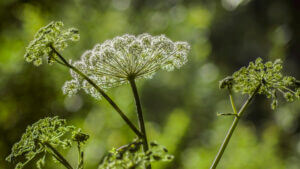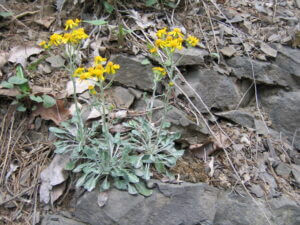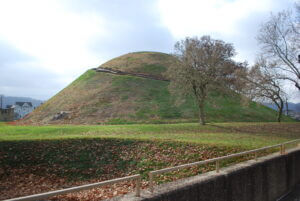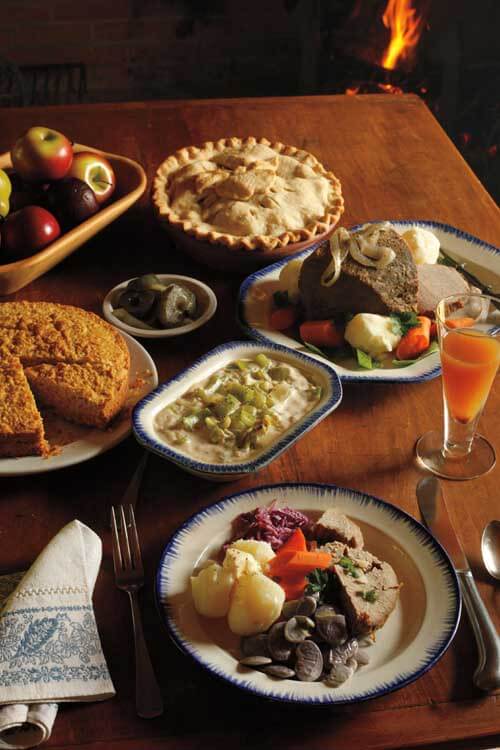

From corn bread to hearty soups, West Virginia’s culinary history is alive and well.
As food historians and hearth cooks, we have gained a knowledge and appreciation of early West Virginia cookery over the past 25 years. Cooking was more laborintensive for our pioneer ancestors. Seasonality meant families ate what was available at particular times of the year. Fresh produce, like strawberries or lettuce, was available only when in season where you lived. When it came time to prepare these foods, cooks were limited by the utensils available. If a cook had only one stew pot or one Dutch oven, one-pot meals were what they prepared.
Challenges presented by the early frontier meant cooks had to improvise and experiment with culturally traditional recipes. The Scots were accustomed to oatcakes cooked on griddles or baking stones, but in the new world they quickly began to use corn meal baked in Dutch ovens.
Tastes changed, too. Traditionally the Scots-Irish used milk fresh, while the Germans and English processed milk into cheese. Germans liked sweet and sour combinations like apples with sauerkraut and pork. The English preferred beef. But in the mountains of western Virginia our ancestors’ food choices changed as they met and lived close to folks from other places. The sharing of “receipts,” or recipes, whether simple or complicated, was as commonplace then as it is now.
The following dishes evoke feelings of deep satisfaction and connection to the past. Though the dishes are old, each can be prepared in your kitchen with a modern interpretation using local ingredients and contemporary techniques and equipment. As you savor some of these historic flavors for the modern palate, consider their individual histories.
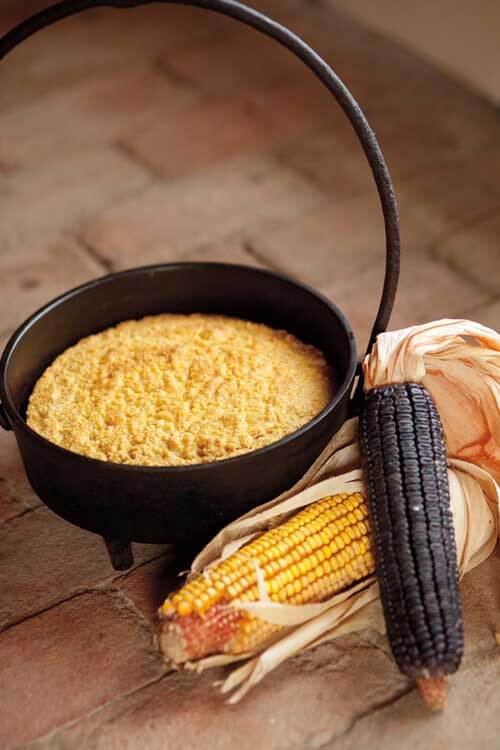
Corn Bread Muffins
The primary grain grown in early western Virginia was corn, which grew well in this climate and produced substantial yields. Corn could be prepared in a multitude of ways and appeared on the pioneer table most days. Corn muffins are a yeast-raised corn bread baked in cups. Corn muffins can also be baked in an iron skillet as one large piece of corn bread, though baking times will need to be extended a little. This recipe came from the manuscript cookery book of Lucy Washington Packet, who was a great-great-niece of George Washington and who lived near Shepherdstown.
Historic Recipe
1 pt. of corn Meal, one pt of flour 4 eggs_one gill of yeast_a little salt as much warm milk as will make the whole into a thick batter. (Lucy Washington Cookbook by Lucy Washington Packett, 1840)
For the modern kitchen
1 cup cornmeal (stone-ground works best)
1 cup unbleached all-purpose flour
½ teaspoon salt
1 ½ teaspoon fast-acting dry yeast
2 eggs
1 cup milk, scalded and cooled to lukewarm
Preheat oven to 400 °. In medium bowl, stir together cornmeal, flour, salt, and yeast. Beat eggs in another medium bowl and slowly pour in cooled milk beating all the while. Add milk mixture to dry ingredients and beat well. Fill 12 well-greased, dark-colored muffin tins half-full. Set in warm place. Let rise 50 to 60 minutes or until doubled in size. Bake 12 to 15 minutes or until golden brown. Serve warm.
Yield: 1 dozen muffins
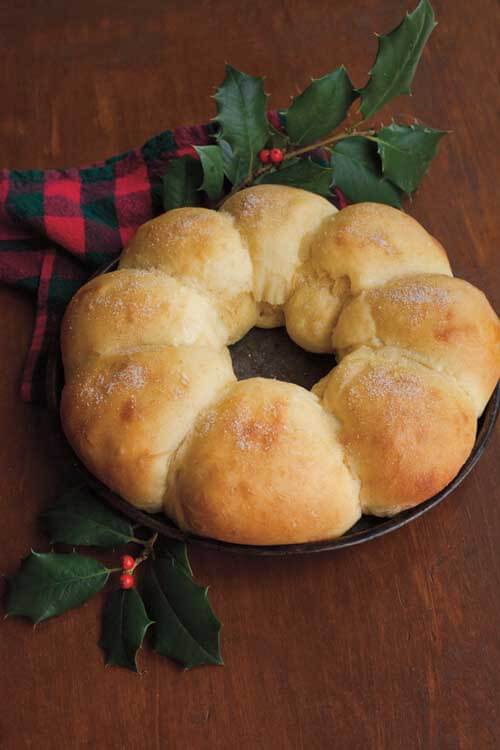
Potato Rolls
After enough land was cleared to grow wheat as well as corn, early settlers began to savor yeast-raised breads. Potato rolls are a delicious example. Valuable wheat flour was supplemented with mashed potatoes, which help to make a wonderfully moist roll. A holiday variation can be prepared with a bit of nutmeg and cinnamon, both available for a pretty price in early storehouses.
Historic Recipe
6 potatoes salt to taste, 2 tablespoons of sugar scant half cup lard teacup of yeats [yeast], 2 eggs well beaten flour enough to make stiff to work let raise, roll out cut, let raise again, then bake. (Housewifery 1837: Sheetz Tavern and Gunshop Shepherdstown, [West] Virginia edited by Gladys Hartzell, 1975)
For the modern kitchen
3 medium white potatoes, about 1 ½ cups, mashed
1 tablespoon sugar, plus ¼ teaspoon
¾ teaspoon salt
3 tablespoons butter or lard
â…“ cup lukewarm water
2 teaspoons fast-acting dry yeast
2 eggs, beaten
3–3 ½ cups unbleached bread flour
Preheat oven to 375 °. Cook potatoes in boiling water until tender. Drain and mash. You may wish to put potatoes through a sieve. In large bowl add tablespoon of sugar, salt, and butter or lard to potatoes and stir well. Dissolve ¼ teaspoon sugar in lukewarm water and stir in yeast. Let yeast mixture stand 5 minutes. Stir beaten eggs into potato mixture. Stir in dissolved yeast. Gradually stir in flour to make a soft dough. Knead dough on lightly floured board for 5 minutes until smooth and elastic. Place dough in a lightly greased bowl, cover with cloth, put in warm place, and let rise about 2 hours until doubled in size. Punch dough down, pinch off dough balls the size of small eggs. Lay on greased dark tin pans. Let rise again until doubled in size. Bake 15 to 20 minutes until golden brown and done in middle.
Yield: approximately 16 rolls
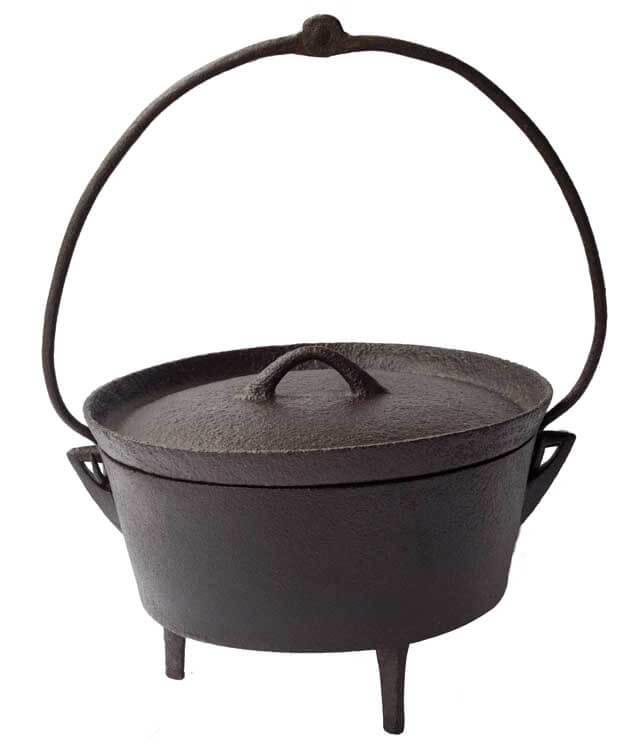
Venison Pasty
This meat pie will gladden the hearts of hungry hunters. It harkens to the meat pies of old England and could be made on the frontier, if a little flour and spice were at hand. Tender chunks of meat—beef will do if you don’t have venison—are seasoned with nutmeg, mace, and pepper and baked in flaky pastry.
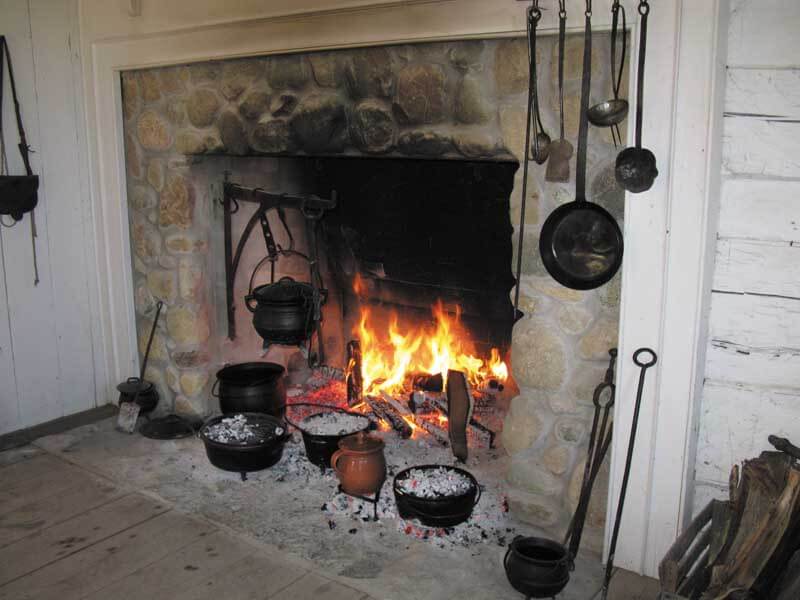
Historic Recipe
The neck, breast, and shoulder are the parts used for a venison pie or pasty. Cut the meat into pieces (fat and lean together) and put the bones and trimmings into a stew-pan with pepper and salt, and water or veal broth enough to cover it. Simmer it till you have drawn out a good gravy. Then strain it. In the mean time make a good rich paste, and roll it rather thick. Cover the bottom and sides of a deep dish with one sheet of it, and put in your meat, having seasoned it with pepper, salt, nutmeg, and mace. Pour in the gravy which you have prepared from the trimmings, and two glasses of port or claret, and lay on the top some bits of butter rolled in flour. Cover the pie with a thick lid of paste, and ornament it handsomely with leaves and flowers formed with a tin cutter. Bake it two hours or more, according to size. (Directions for Cookery by Eliza Leslie, 1840)
For the modern kitchen
2 tablespoons shortening
2 pounds venison shoulder roast or 2 pounds beef chuck or shoulder roast, cut in 1-inch cubes
3–4 cups water ¼ teaspoon salt, plus ¼ teaspoon
¼ teaspoon pepper, plus ¼ teaspoon
2 (8-inch) pie crusts ¼ teaspoon nutmeg
¼ teaspoon mace
¼ cup red wine
1 ½ tablespoons butter, cut fine and rolled in 2 tablespoons flour
Preheat oven to 425 °. In a heavy-bottomed Dutch oven, melt shortening over medium heat. Brown meat 8 to 10 minutes in hot shortening, stirring frequently. Add water, ¼ teaspoon salt, ¼ teaspoon pepper, and any bones that came with the meat. Bring water to a boil, reduce heat to a simmer, skim off foam, and continue simmering, covered, for about 2 hours or until meat is tender. Replenish the water if it boils away during the cooking. At the end of 2 hours, remove meat from broth. Strain the broth and if there is more than ¾ cup, return it to the heat and boil it down until ¾ cup remains. Line an 8-inch pie pan with pastry; lay meat chunks in pastry, sprinkle it with the remaining salt and pepper, nutmeg, and mace. Pour in the wine and meat broth. Dot top of meat with butter rolled in flour. Put on top crust. Cut vent holes in top crust. From pastry scraps cut out leaf or flower shapes, moisten the backs with drops of water, and lay pastry shapes on top of piecrust. Bake 12 minutes at 425 °, reduce heat, and bake at 400 ° for 20 to 30 minutes or until pastry is brown and filling is bubbling. Remove from oven, cool slightly on rack. Serve warm as a main dish accompanied with green vegetables and fruit.
Yield: 4 servings
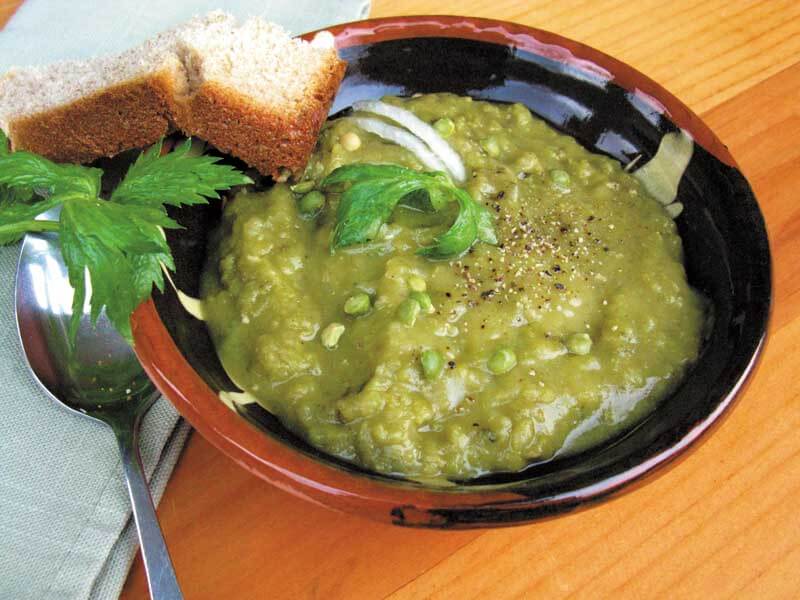
Pea Soup
Fragrant, warm soup on a blustery winter day has been a comfort food for centuries. Our pea soup is made with dried peas, a long-lasting staple in early times. Our original version of this recipe was found in an 1823 Clarksburg newspaper.
Historic Recipe
To two quarts of peas put two gallons of water, three large onions, & a handful of parsley, a little thyme, peper [pepper], and salt. (Clarksburg Intelligencer, September 20, 1823, p. 3)
For the modern kitchen
8 cups hot water
2 cups dried green split peas
1 medium onion, chopped
2 tablespoons fresh parsley, chopped
½ teaspoon dried thyme
½ teaspoon freshly ground black pepper
½ teaspoon salt
2 tablespoons butter, optional
2 tablespoons cheese, freshly grated, optional
In a large kettle, place water, peas, onion, parsley, thyme, pepper, and salt. Bring to a boil and reduce heat. Simmer 4 hours or until peas are completely cooked. Check seasoning and add more if necessary. Stir in butter if desired. Ladle into soup plates and garnish with cheese and pepper, to taste. Serve with crusty bread and fresh fruit.
Yield: 6 servings
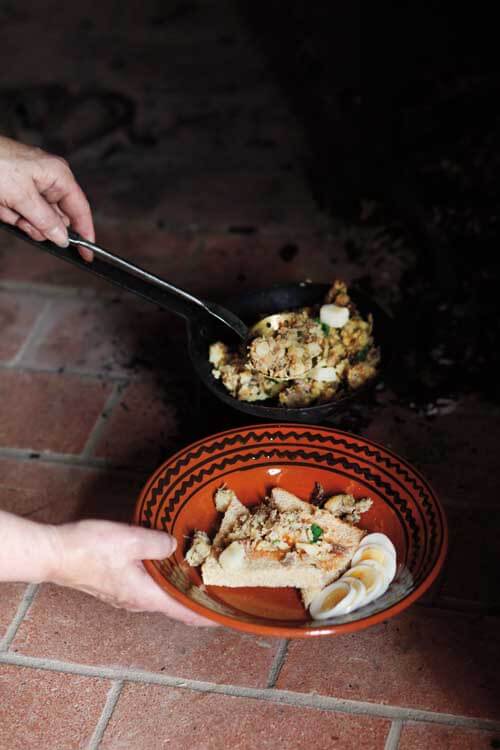
Hash
Leftovers can be the bane or blessing of any cook. In pioneer times, especially during warm weather, leftover food had to be eaten quickly so it wouldn’t spoil. One of the ways to use up cooked meat was to chop it fine, add ingredients like onions, potatoes, and seasonings, and reheat it quickly in a skillet. Since it is all chopped, or “hashed up,” this quick medley came to be known as hash. This 1840s recipe is delicious when served over toast and garnished with a hard-cooked egg. Meats including venison, small game, or poultry can be hashed.
Historic Recipe
Chop meat well 2 or 3 potatoes 2 onions salt pepper and a little mustard Tablespoonful of vinegar if you chose Chip up a hard boild egg and slice some bread up and toast it and put it in the bottom of dish. (Lucy Washington Cookbook by Lucy Washington Packett, 1840)
For the modern kitchen
¼ cup onion, finely chopped
2 tablespoons shortening
1 cup roast beef, finely chopped
1 cup boiled or baked potato, cubed
â…›– ¼ teaspoon freshly ground black pepper
1 teaspoon mustard
1 tablespoon cider vinegar, optional
salt to taste
½–1 cup well-seasoned beef broth or water
2 slices toast
1 hard-cooked egg, sliced
In medium skillet, gently sauté onion in shortening until transparent. Stir in beef, potato, and seasonings. Cook over medium heat until warmed through, adding beef broth or water just to keep moistened. Put a slice of toast on each of two plates, cover with hash, garnish with sliced egg, and serve immediately. Fresh fruit and a green vegetable go well with this quick meal.
Yield: 2 servings
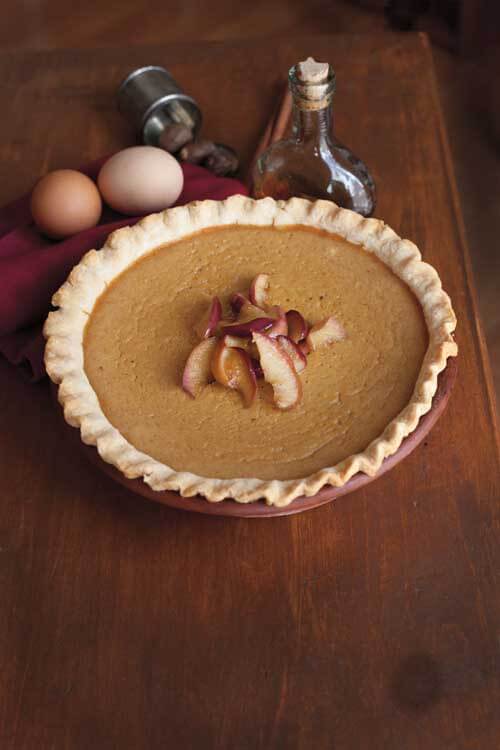
Apple Pudding
Early settlers liked a sweet dish as well as we do today, but white sugar was expensive and sometimes hard to come by. Brown sugar, honey, maple sugar, and molasses were often substituted in foods we would call desserts. Pies were a favored dish, even for breakfast. Any fruit or vegetable, or even meat, could be encased in pastry and baked. The recipe name of “pudding” was often interchangeable with what we call a one-crust pie, as in this apple pudding recipe. It’s interesting to note the brevity and lack of instructions in our historic recipe from 1814.
Historic Recipe
Take one pound of apples stew them & sweten [sweeten] them to your taste add some spice one glass wine on[e] of Brandy and four eggs beat to a froth. (Miss Catharine Baker’s Receipt Book by Catharine Baker, 1814)
For the modern kitchen
3 tablespoons white sugar
3 tablespoons brown sugar
½ teaspoon freshly ground nutmeg
1 teaspoon ground cinnamon
1 pound cooking apples, peeled, cored, cooked, mashed, and cooled, or 2 cups of prepared, unsweetened applesauce warmed in microwave
¼ cup brandy (apricot recommended)
¼ cup sweet white wine
4 eggs, beaten
Preheat oven to 350 °. In large bowl, mix spices with sugars and stir together with applesauce. Let cool. Stir brandy and wine into beaten eggs. Mix eggs with applesauce mixture. Pour into 8 custard cups, set cups in cake pan containing ½ inch water. Place pan in oven and bake 45 to 50 minutes or until table knife inserted in middle comes out clean. Remove from pan, let cool, and refrigerate. Serve cold. This apple pudding is more like a baked custard made with applesauce.
Yield: 8 servings
Alternate method of baking: Pour Apple Pudding mixture into 9-inch unbaked pie pastry shell and bake at 425 ° for 10 minutes, then reduce heat to 350 ° and bake 50 to 60 minutes more or until table knife inserted near the center comes out clean.
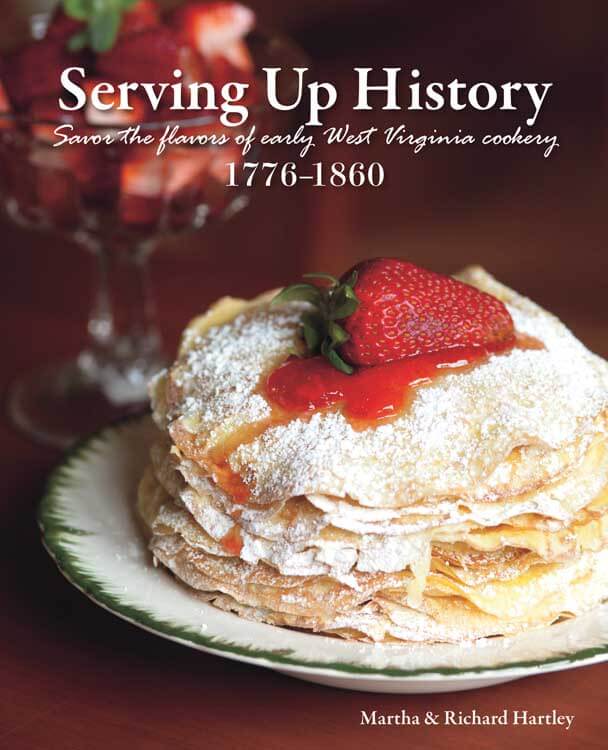
These recipes and more can be found in the recently published book Serving Up History: Savor the Flavors of Early West Virginia Cookery 1776–1860 written by Martha and Richard Hartley. This book contains more than 100 historic recipes that have been translated into modern terms and illustrated with colorful photos. There are also cook’s notes and historic insights to give more information about the recipes, as well as a chapter called “Gone Visiting” in which the authors visit historic sites in West Virginia and offer menus and recipes suitable to the sites’ time periods and locations. Visit wvhearthcook.com for more information.
This story was originally published in the February 2016 issue of Wonderful West Virginia.
written by Martha & Richard Hartley
photographed by Carla Witt Ford



